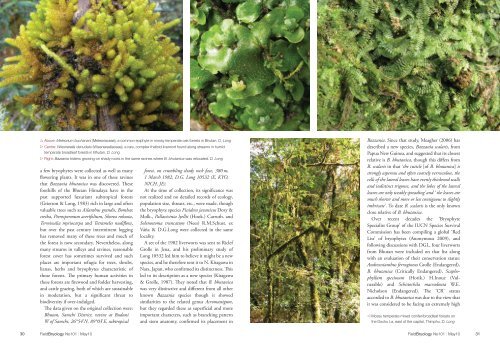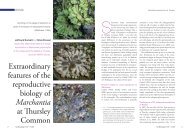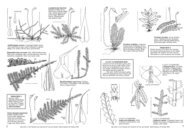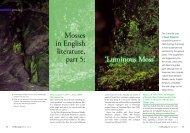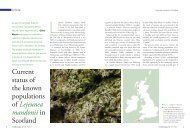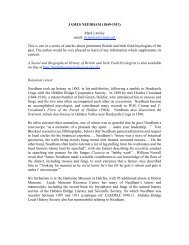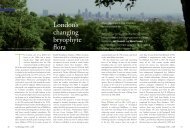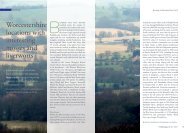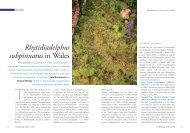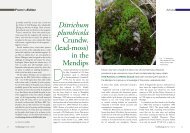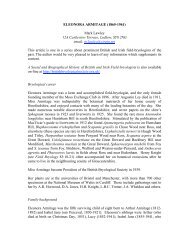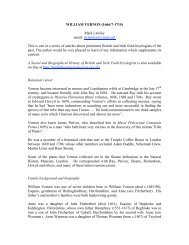The rediscovery and conservation status of Bazzania bhutanica in ...
The rediscovery and conservation status of Bazzania bhutanica in ...
The rediscovery and conservation status of Bazzania bhutanica in ...
You also want an ePaper? Increase the reach of your titles
YUMPU automatically turns print PDFs into web optimized ePapers that Google loves.
<strong>Bazzania</strong> <strong>bhutanica</strong> <strong>in</strong> Bhutan<br />
n Above: Meteorium buchanani (Meteoriaceae), a common epiphyte <strong>in</strong> mossy temperate oak forests <strong>in</strong> Bhutan. D. Long<br />
x Centre: Wiesnerella denudata (Wiesnereallaceae), a rare, complex thalloid liverwort found along streams <strong>in</strong> humid<br />
temperate broadleaf forests <strong>in</strong> Bhutan. D. Long<br />
x Right: <strong>Bazzania</strong> tridens grow<strong>in</strong>g on shady rocks <strong>in</strong> the same rav<strong>in</strong>es where B. <strong>bhutanica</strong> was relocated. D. Long<br />
a few bryophytes were collected as well as many<br />
flower<strong>in</strong>g plants. It was <strong>in</strong> one <strong>of</strong> these rav<strong>in</strong>es<br />
that <strong>Bazzania</strong> <strong>bhutanica</strong> was discovered. <strong>The</strong>se<br />
foothills <strong>of</strong> the Bhutan Himalaya have <strong>in</strong> the<br />
past supported luxuriant subtropical forests<br />
(Grierson & Long, 1983) rich <strong>in</strong> large <strong>and</strong> <strong>of</strong>ten<br />
valuable trees such as Ailanthus gr<strong>and</strong>is, Bombax<br />
creiba, Pterospermum acerifolium, Shorea robusta,<br />
Term<strong>in</strong>alia myriocarpa <strong>and</strong> Tetrameles nudiflora,<br />
but over the past century <strong>in</strong>termittent logg<strong>in</strong>g<br />
has removed many <strong>of</strong> these trees <strong>and</strong> much <strong>of</strong><br />
the forest is now secondary. Nevertheless, along<br />
many streams <strong>in</strong> valleys <strong>and</strong> rav<strong>in</strong>es, reasonable<br />
forest cover has sometimes survived <strong>and</strong> such<br />
places are important refugia for trees, shrubs,<br />
lianas, herbs <strong>and</strong> bryophytes characteristic <strong>of</strong><br />
those forests. <strong>The</strong> primary human activities <strong>in</strong><br />
these forests are firewood <strong>and</strong> fodder harvest<strong>in</strong>g,<br />
<strong>and</strong> cattle graz<strong>in</strong>g, both <strong>of</strong> which are susta<strong>in</strong>able<br />
<strong>in</strong> moderation, but a significant threat to<br />
biodiversity if over-<strong>in</strong>dulged.<br />
<strong>The</strong> data given on the orig<strong>in</strong>al collection were:<br />
Bhutan, Samchi District, rav<strong>in</strong>e at Buduni<br />
W <strong>of</strong> Samchi, 26°54ʹN, 89°03ʹE, subtropical<br />
forest, on crumbl<strong>in</strong>g shady rock face, 380 m,<br />
1 March 1982, D.G. Long 10532 (E, KYO,<br />
NICH, JE).<br />
At the time <strong>of</strong> collection, its significance was<br />
not realized <strong>and</strong> no detailed records <strong>of</strong> ecology,<br />
population size, threats, etc., were made, though<br />
the bryophyte species Fissidens javanicus Dozy &<br />
Molk., Pallavic<strong>in</strong>ia lyellii (Hook.) Carruth. <strong>and</strong><br />
Solenostoma truncatum (Nees) R.M.Schust. ex<br />
Váňa & D.G.Long were collected <strong>in</strong> the same<br />
locality.<br />
A set <strong>of</strong> the 1982 liverworts was sent to Riclef<br />
Grolle <strong>in</strong> Jena, <strong>and</strong> his prelim<strong>in</strong>ary study <strong>of</strong><br />
Long 10532 led him to believe it might be a new<br />
species, <strong>and</strong> he therefore sent it to N. Kitagawa <strong>in</strong><br />
Nara, Japan, who confirmed its dist<strong>in</strong>ctness. This<br />
led to its description as a new species (Kitagawa<br />
& Grolle, 1987). <strong>The</strong>y noted that B. <strong>bhutanica</strong><br />
was very dist<strong>in</strong>ctive <strong>and</strong> different from all other<br />
known <strong>Bazzania</strong> species though it showed<br />
similarities to the related genus Acromastigum,<br />
but they regarded these as superficial <strong>and</strong> more<br />
important characters, such as branch<strong>in</strong>g pattern<br />
<strong>and</strong> stem anatomy, confirmed its placement <strong>in</strong><br />
<strong>Bazzania</strong> <strong>bhutanica</strong> <strong>in</strong> Bhutan<br />
<strong>Bazzania</strong>. S<strong>in</strong>ce that study, Meagher (2006) has<br />
described a new species, <strong>Bazzania</strong> scalaris, from<br />
Papua New Gu<strong>in</strong>ea, <strong>and</strong> suggested that its closest<br />
relative is B. <strong>bhutanica</strong>, though this differs from<br />
B. scalaris <strong>in</strong> that ‘the cuticle [<strong>of</strong> B. <strong>bhutanica</strong>] is<br />
strongly asperous <strong>and</strong> <strong>of</strong>ten coarsely verruculose, the<br />
cells <strong>of</strong> the lateral leaves have evenly thickened walls<br />
<strong>and</strong> <strong>in</strong>dist<strong>in</strong>ct trigones, <strong>and</strong> the lobes <strong>of</strong> the lateral<br />
leaves are only weakly spread<strong>in</strong>g’ <strong>and</strong> ‘ the leaves are<br />
much shorter <strong>and</strong> more or less contiguous to slightly<br />
imbricate’. To date B. scalaris is the only known<br />
close relative <strong>of</strong> B. <strong>bhutanica</strong>.<br />
Over recent decades the ‘Bryophyte<br />
Specialist Group’ <strong>of</strong> the IUCN Species Survival<br />
Commission has been compil<strong>in</strong>g a global ‘Red<br />
List’ <strong>of</strong> bryophytes (Anonymous 2009), <strong>and</strong><br />
follow<strong>in</strong>g discussions with DGL, four liverworts<br />
from Bhutan were <strong>in</strong>cluded on that list along<br />
with an evaluation <strong>of</strong> their <strong>conservation</strong> <strong>status</strong>:<br />
Andrewsianthus ferrug<strong>in</strong>eus Grolle (Endangered),<br />
B. <strong>bhutanica</strong> (Critically Endangered), Scaphophyllum<br />
speciosum (Horik.) H.Inoue (Vulnerable)<br />
<strong>and</strong> Schistochila macrodonta W.E.<br />
Nicholson (Endangered). <strong>The</strong> ‘CR’ <strong>status</strong><br />
accorded to B. <strong>bhutanica</strong> was due to the view that<br />
it was considered to be fac<strong>in</strong>g an extremely high<br />
v Mossy temperate mixed conifer/broadleaf forests on<br />
the Dochu La, east <strong>of</strong> the capital, Thimphu. D. Long<br />
30 FieldBryology No101 | May10 FieldBryology No101 | May10 31


